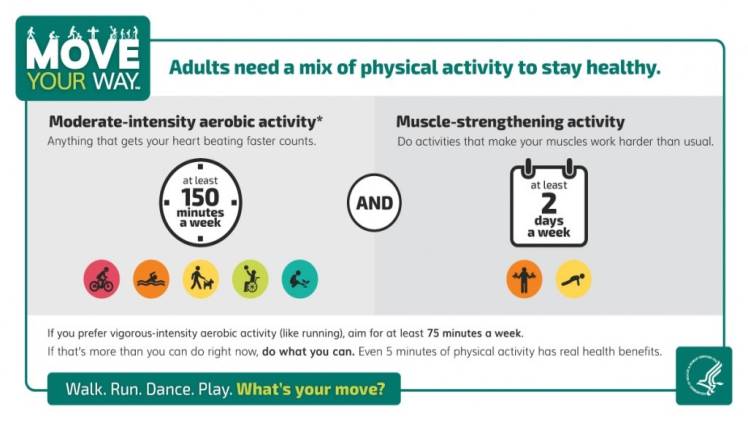Physical Activity Guidelines for Americans

Exercise is one of the most efficient ways to combat chronic illnesses, manage multiple medical co-morbidities and enhance quality of life.
Despite the many advantages of physical activity, only half of Americans get the recommended amount of exercise. The 2008 Physical Activity Guidelines for Americans provide guidance to help individuals understand what it takes to stay healthy and move more often.
The guidelines suggest a range of activities to meet various health objectives. These include aerobic (cardiovascular), muscle-strengthening exercises, flexibility training and neuromotor (balance and coordination) training.
Adults should commit to at least 150 minutes of moderate-intensity aerobic activity per week, 75 minutes of vigorous-intensity aerobic activity or both. Additionally, they should perform muscle strengthening exercises involving all major muscle groups at least two days each week.
Youth aged 3 to 17 should engage in at least an hour of light-to-moderate aerobic activity each day, such as walking, running or playing sports. Additionally, they should do strength-training exercises that work all major muscle groups, like lifting weights or doing push-ups.
Older adults should complete 150 minutes of moderate-intensity cardiovascular activity per week, or 75 minutes of vigorous cardiovascular activity or a combination of both. Additionally, they should perform muscle-strengthening exercises involving all major muscle groups on at least two days each week (such as lifting weights, doing push-ups or stretching).
Children aged 4 to 5 should complete at least 60 minutes of light-to-moderate aerobic activity each day, or 75 minutes of vigorous intensity activity. Additionally, they should do muscle strengthening exercises that target all major muscle groups on at least two days per week, such as squats, sit-ups or push-ups.
According to the guidelines, children aged 6-12 should get at least 60 minutes of light-to-moderate physical activity each day, or 75 minutes of vigorous intensity activity. They also need to do muscle strengthening exercises that work all major muscle groups such as squats, sit-ups, push-ups or sit-downs on at least two days each week.
World Health Organization guidelines offer scientific evidence-based guidance on how much physical activity benefits different population groups and the potential risks of sedentary behavior. They aim to support global, regional and national policy actions and investments as well as strengthen national surveillance systems that measure progress towards national targets.
